While women are achieving more educationally and participating more in the labor force than ever before, there is a widespread perception among the public that full equality between men and women remains an elusive goal. Only four-in-ten Americans say that society generally treats men and women equally. Attitudes have changed considerably in this regard over the past 20 years. Even so, a sizable minority of adults (45%) still say that society favors men over women, down from 62% in 1993.
When it comes to the workplace, there is an even stronger sense among the public that the playing field is uneven. A strong majority of Americans say the country needs to continue making changes to give men and women equality in this realm. Some 55% believe that men earn more money than women for doing the same job, and nearly half say there’s a gender gap in hiring and promotions when it comes to the top jobs in business and government. There is a disconnect, however, between these public perceptions and what people actually experience in their workplace. Very few adults say these gender gaps exist where they work.
This section will examine attitudes about gender equality, the wage gap and the glass ceiling. It will look at the experiences of men and women in the workplace and address what the public sees as the most important reasons for the inequalities that persist.
Does Society Treat Men and Women Equally?
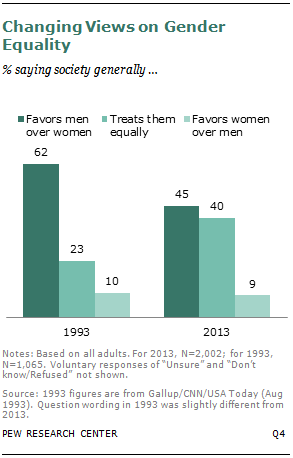 The public is divided on the basic question of how society treats men and women. Four-in-ten say society generally treats men and women equally. A slightly larger share (45%) says society favors men over women. Only 9% say society favors women over men. Attitudes have changed considerably over the past 20 years. When the Gallup Organization asked this question in 1993, only 23% said society generally treats men and women equally, and 62% said society favors men over women.27
The public is divided on the basic question of how society treats men and women. Four-in-ten say society generally treats men and women equally. A slightly larger share (45%) says society favors men over women. Only 9% say society favors women over men. Attitudes have changed considerably over the past 20 years. When the Gallup Organization asked this question in 1993, only 23% said society generally treats men and women equally, and 62% said society favors men over women.27
There’s a significant gender gap on this issue. Roughly half of men (46%) say that men and women are generally treated equally by society, while only 34% of women agree. Roughly half (53%) of women say society favors men over women, compared with 36% of men who say the same.
The perception among women that men receive more favorable treatment cuts across generations. Roughly equal shares of Millennial women (51%), Gen X women (55%), Boomer women (54%) and Silent generation women (58%) say that society generally favors men over women.
College-educated women are among the most likely to say men and women are not treated equally by society. Fully 65% of women with a bachelor’s degree or higher say society favors men over women. This compares with 49% of women without a bachelor’s degree. Similarly, college-educated men (46%) are more likely than men who have not graduated from college (32%) to say society is biased in favor of men.
Equality in the Workplace—Are We There Yet?
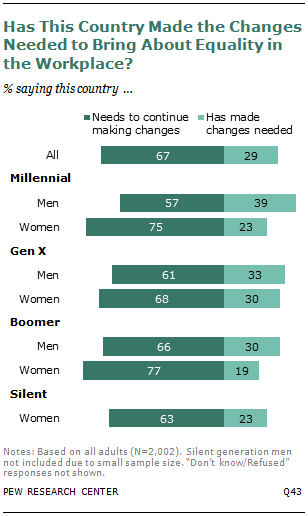 When respondents are asked specifically about conditions in the workplace, there is a strong sense that more needs to be done to bring about gender equality. Only 29% of adults say this country has made the changes needed to give men and women equality in the workplace, while 67% say the country needs to continue making changes. There is a significant gender gap on this question, but even among men, 61% say more changes are needed. Roughly
When respondents are asked specifically about conditions in the workplace, there is a strong sense that more needs to be done to bring about gender equality. Only 29% of adults say this country has made the changes needed to give men and women equality in the workplace, while 67% say the country needs to continue making changes. There is a significant gender gap on this question, but even among men, 61% say more changes are needed. Roughly
seven-in-ten women (72%) say more change is needed.
The gender gap is particularly wide among Millennials: While 75% of Millennial women say more changes are needed to bring about equality in the workplace, only 57% of Millennial men agree. The gender gap is narrower among Gen Xers and Boomers.
Women’s views are united across generations. Boomer women, who’ve lived through an era of tremendous growth in terms of women’s labor market participation, are just as likely as Millennial women to say more changes need to be made in order to have gender equality in the workplace (77% and 75%, respectively). Gen X women have a similar view (68% say more needs to be done).
A strong majority of conservative women (62%) say the country needs to continue making changes to give men and women equality in the workplace. Liberal women feel even more strongly about this (87% say more needs to be done). Moderates fall in the middle (76%).
There is a significant racial divide on this question. Overall, blacks (85%) are more likely than whites (63%) or Hispanics (64%) to say the country needs to continue making changes to give men and women equality in the workplace. The racial gap is larger among men than among women. While 83% of black men say the country needs to make more changes to bring about equality, only 56% of white men and 64% of Hispanic men agree. Among women, 86% of blacks, 70% of whites and 63% of Hispanics say more change is needed.
Equal Pay for Equal Work?
The fact that there’s a wage gap between men and women is not lost on the public. Some 55% of adults believe that men generally earn more than women these days for the same work. But a sizable minority (38%) says if a man and a woman are doing the same work, they earn the same amount of money.
The perception that there was a wage gap in favor of men was much more widespread 30 years ago. In a 1982 CBS News poll, 70% of adults said men earned more than women for doing the same work.
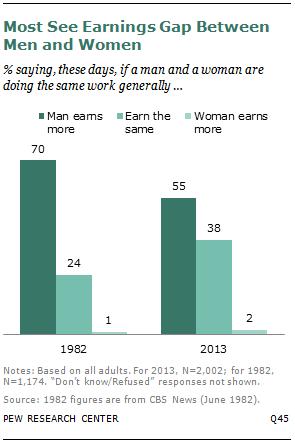 Today, there is a significant gender gap in views about how men and women are paid. A strong majority of women (62%) say that if a man and a woman are doing the same work, the man generally earns more; only 47% of men agree.
Today, there is a significant gender gap in views about how men and women are paid. A strong majority of women (62%) say that if a man and a woman are doing the same work, the man generally earns more; only 47% of men agree.
Women are fairly united in their views on this question. The perception that men are generally paid more than women for doing the same work cuts across different generations of women. The one exception is women in the Silent generation, 72% of whom say men generally earn more than women (statistically higher than the share of Millennial or Gen X women who say the same). Equal shares (62%) of women with and without children say men generally out-earn women.
There is a significant education gap on this question, however. Women with a bachelor’s degree or higher are much more likely than women with less education to say men generally earn more than women (73% vs. 55%). There is a similar education gap among men, although it is not as wide—55% of men with a bachelor’s degree or higher vs. 45% of men with less education say men generally earn more than women.
Women who believe the country has made the changes needed to bring about gender equality in the workplace tend to also believe men and women are given equal pay for doing the same work. Only 33% of the women in this group say men generally earn more than women. By contrast, a solid majority of women who say the country needs to do more to bring about gender equality in the workplace also believe men out-earn women (73% say men generally earn more than women for doing the same job, and only 23% say men and women earn the same amount).
Do Women Have an Equal Shot at Top Executive Jobs?
 While women have made substantial gains in the workplace in recent decades, there is clear evidence that women remain underrepresented at the top levels of American business and politics. According to recent research from Catalyst, women currently hold 4.2% of Fortune 500 CEO positions and 4.5% of Fortune 1000 CEO positions.28 And when it comes to politics, women hold 18% of the seats in the U.S. Congress and 23% of statewide elected executive offices.29
While women have made substantial gains in the workplace in recent decades, there is clear evidence that women remain underrepresented at the top levels of American business and politics. According to recent research from Catalyst, women currently hold 4.2% of Fortune 500 CEO positions and 4.5% of Fortune 1000 CEO positions.28 And when it comes to politics, women hold 18% of the seats in the U.S. Congress and 23% of statewide elected executive offices.29
When it comes to getting a top job in business or government, the public is divided over whether men have an advantage over women or whether gender doesn’t make a difference. Some 46% of all adults say it’s easier for men to get top executive jobs, and 43% say gender doesn’t make a difference. Only 5% say it’s easier for women to get top jobs these days.
Views on this issue have changed significantly in recent decades. Thirty years ago, a CBS News poll found that 67% of the public believed men had an advantage when it came to getting top executive jobs in business and government. Only 23% thought gender didn’t make a difference.
Today, men and women have very different views on this issue. On balance, women are more likely to say it’s easier for men to get top executive jobs in business or government these days than they are to say that the playing field is level. Some 54% of women say it’s easier for men to get top jobs, while 38% say there isn’t much difference. Only 3% of women say it’s easier for women to get top jobs these days.
Among men, the balance of opinion is different. Only 38% of men say it’s easier for men to get top jobs in business and government these days, while 48% say there’s no difference between men and women in this regard.
Women across generations agree about the ability for women to get top executive jobs these days. About six-in-ten Millennial and Boomer women (each 58%) and 55% of Gen X women say that it is easier for men to get these positions. The views of Silent generation women are somewhat different: 41% say it is easier for men to get these positions.
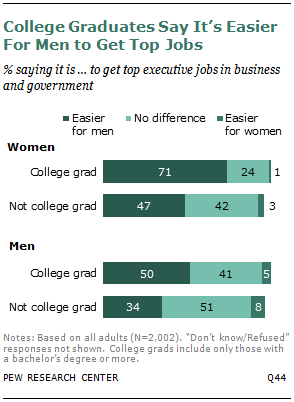 The education gap on this question is particularly wide—for both men and women. Overall, college-educated adults are much more likely than those without a four-year college degree to say men have an advantage when it comes to hiring for executive-level positions. Among women, 71% of those with a bachelor’s degree or higher say it’s easier for men to get top jobs in business or government. Only 47% of women without a bachelor’s degree agree. This is relevant, because college-educated women are more likely than their counterparts with less education to be competing for top-level jobs. Among men, 50% of those with a four-year college degree say it’s easier for men to get top jobs, while only 34% of men without a bachelor’s degree agree with this assessment.
The education gap on this question is particularly wide—for both men and women. Overall, college-educated adults are much more likely than those without a four-year college degree to say men have an advantage when it comes to hiring for executive-level positions. Among women, 71% of those with a bachelor’s degree or higher say it’s easier for men to get top jobs in business or government. Only 47% of women without a bachelor’s degree agree. This is relevant, because college-educated women are more likely than their counterparts with less education to be competing for top-level jobs. Among men, 50% of those with a four-year college degree say it’s easier for men to get top jobs, while only 34% of men without a bachelor’s degree agree with this assessment.
Perceptions Don’t Match Experiences
In spite of the general perception, especially among women, that men have an advantage in terms of earning power and access to top jobs, relatively few employed adults report these types of inequities at their own workplace. Solid majorities of working men (73%) and women (75%) say that where they work, men and women are paid about the same amount for doing the same job. Some 14% of women and 9% of men say, at their workplace, women are paid less than men for doing the same job, and relatively few (4% of men and 3% of women) say women are paid more than men.
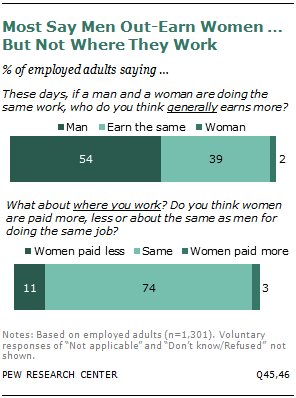 Among those who are employed, blacks are about twice as likely as whites or Hispanics to report that women are paid less in their workplace. One-in-five blacks say women are paid less than men where they work. This compares with one-in-ten of both whites and Hispanics.
Among those who are employed, blacks are about twice as likely as whites or Hispanics to report that women are paid less in their workplace. One-in-five blacks say women are paid less than men where they work. This compares with one-in-ten of both whites and Hispanics.
Women who believe the country needs to do more to bring about equality in the workplace are significantly more likely than those who say the country has done enough to say that women are paid less than men in their workplace (17% vs. 5%). Even so, 71% of women who believe the country still needs to make changes to bring about gender equality say that, at least where they work, men and women who do the same job earn about the same amount of money.
Just as most employed adults say there is no gender wage gap where they work, a solid majority say men and women have about the same opportunities for promotions or advancement. Overall, 73% of adults who work either full time or part time say that at their workplace, women have about the same opportunities as men to advance in their job. Some 14% say women have fewer opportunities for promotions or advancement, and 8% say women have greater opportunities than men in this regard.
Men and women have similar views on this issue. Fully 73% of men and 72% of women say that at their workplace, men and women have the same opportunities for advancement.
Among working women, Boomers are somewhat more likely than Millennials to say women in their workplace have fewer opportunities than men to advance (23% vs. 10%). Gen Xer women fall in the middle (17%). Fully 79% of Millennial women say that where they work, women have about the same chance as men do for advancement.
Perceptions do not vary depending on whether women have themselves sought out a raise or promotion. Roughly equal shares of women who say they have asked for a pay raise or promotion and those who say they have not done so report that, at their workplace, men and women have about the same opportunities for advancement. But women who say the country needs to make more changes to reach gender equality in the workplace are much more likely than women who think the necessary changes have already been made to say that the women at their place of work have fewer opportunities than the men (21% vs. 9%).
No Public Consensus on Underlying Causes of Gender Wage Gap
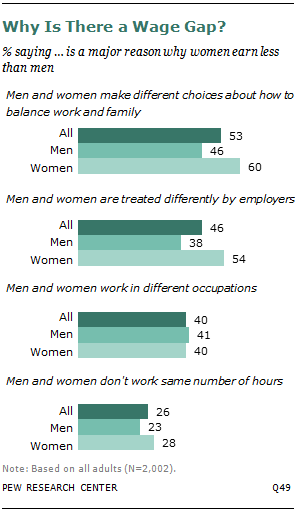 As the economic data in Chapter 1 make clear, there is a gap in wages between men and women. It may be shrinking, but it still exists, and a variety of factors may contribute to this gap. Respondents were asked to evaluate the importance of a few of these factors. The most compelling explanation for the wage gap, according to the public, is that men and women make different choices about how to balance work and family. About half of all adults (53%) say this is a major reason that women earn less than men. An additional 26% say this is a minor reason for the gender wage gap, and 16% say it’s not a reason at all.
As the economic data in Chapter 1 make clear, there is a gap in wages between men and women. It may be shrinking, but it still exists, and a variety of factors may contribute to this gap. Respondents were asked to evaluate the importance of a few of these factors. The most compelling explanation for the wage gap, according to the public, is that men and women make different choices about how to balance work and family. About half of all adults (53%) say this is a major reason that women earn less than men. An additional 26% say this is a minor reason for the gender wage gap, and 16% say it’s not a reason at all.
Some 46% of all adults say that differential treatment by employers is a major reason that women earn less than men. Four-in-ten adults say the fact that men and women work in different occupations is a major reason. And a quarter (26%) say the fact that men and women don’t work the same number of hours is a major reason for the gap.
There are significant gender gaps on this question, particularly with regard to the choices men and women make about balancing work and family and differential treatment by employers. Women are much more likely than men to see both of these explanations as major reasons for the wage gap. Fully 60% of women say the fact that women and men make different choices about how to balance work and family is a major reason that women earn less than men; 46% of men agree this is a major reason. A similar share of women (54%) say a major reason for the gender wage gap is that men and women are treated differently by employers. Only 38% of men agree that this is a major reason for the gap.
Economic data confirm that women work fewer hours per week, on average, than men.30 The public sees this as a less compelling explanation for the gender wage gap. Women are somewhat more likely than men to say this is a major reason that women earn less than men (28% vs. 23%). And among women, mothers, non-whites and those with less than a college education are particularly likely to see this as a major factor.
Women with children under the age of 18 are more likely than women without young children to say the choices men and women make about balancing work and family are a major reason for the gender wage gap (66% vs. 57%). Women who don’t have a college degree are more likely than college graduates to point to differences in occupations and work hours as important reasons that women earn less than men.
Women who say that the country needs to continue working toward a goal of gender equality in the workplace are more likely than women who say that goal has already been reached to say that differential treatment by employers is a major reason for the gender wage gap (63% vs. 32%).
Who’s More Focused on Career: Men or Women?
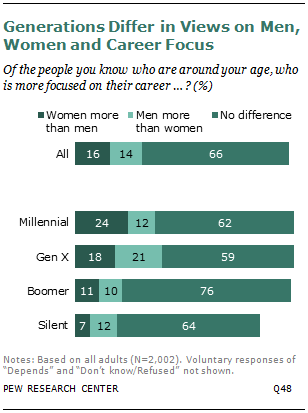 Previous analysis by the Pew Research Center shows that while men’s and women’s roles at work and at home have converged quite a bit in recent decades, men still spend more time on average on paid work, while women spend more time on child care and housework. Even so, most Americans (66%) say that among the people their age that they know, men and women are about equally focused on their jobs or careers. Some 14% say the men they know are more focused on their careers than the women, and an equal share (16%) say the women are more focused on their careers.
Previous analysis by the Pew Research Center shows that while men’s and women’s roles at work and at home have converged quite a bit in recent decades, men still spend more time on average on paid work, while women spend more time on child care and housework. Even so, most Americans (66%) say that among the people their age that they know, men and women are about equally focused on their jobs or careers. Some 14% say the men they know are more focused on their careers than the women, and an equal share (16%) say the women are more focused on their careers.
There is no significant gender gap on this question. Roughly two-thirds of men (67%) and women (64%) say that among the people they know, both genders are equally focused on their careers.
There is an interesting generation gap on this question. Majorities of Millennials, Gen Xers, Boomers and Silents say that among the people they know, men and women are equally focused on their jobs or careers. However, Millennials (24%) are more likely than their older counterparts to say the women they know are more focused on their careers than are the men they know. Gen Xers (21%) are more likely than those in other generations to say the men they know are more focused on their careers, but 18% still say women their age are more focused than men. Boomers are more likely than any other group to say that among the people they know, men and women are about equally focused on their careers (76%).
Income and education gaps also exist on this question. Adults with annual family incomes of $75,000 or higher are more likely than less affluent adults to say that the men they know are more focused on their careers than are the women they know. By contrast, those with incomes of $30,000 a year or lower are more apt to say the women they know are more focused on their careers than the men. In addition, adults with a bachelor’s degree are more likely than adults with less education to say that the men they know are more focused on their careers than the women (19% vs. 12%). And those with less education are somewhat more likely than college graduates to say the women their age are more focused on their careers (18% vs. 13%). Still, majorities in all income and education groups say the men and women they know are equally focused on their jobs or careers.
Opinions also vary by race and ethnicity. While white adults are more likely to say that the men they know are more focused on their careers (16%), blacks and Hispanics are more likely to say that the women they know are more career-focused (25% and 26%, respectively).
Do Men and Women Care about the Gender of Their Co-Workers?
While there are still some male- and female-dominated occupations in the U.S., the workplace is much more gender integrated these days than it was 50 years ago. Still, a substantial minority of adults think that men would prefer to work alongside other men. When asked whether men mostly prefer having other men or women as co-workers, or whether it doesn’t matter, 36% of all adults say that men prefer to work with other men. Only 8% believe men prefer to have women as co-workers, and about half (52%) say they don’t think it matters to men one way or the other.
 There is a significant gender gap in perceptions about what men prefer. Some 40% of female respondents say that men mostly prefer working with other men. By comparison, 32% of male respondents say the same. Among male respondents, 58% say they think it “doesn’t matter to men,” higher than the 46% among female respondents. Millennials of both genders are more likely than older generations to believe that men prefer having women as co-workers.
There is a significant gender gap in perceptions about what men prefer. Some 40% of female respondents say that men mostly prefer working with other men. By comparison, 32% of male respondents say the same. Among male respondents, 58% say they think it “doesn’t matter to men,” higher than the 46% among female respondents. Millennials of both genders are more likely than older generations to believe that men prefer having women as co-workers.
Respondents were also asked about women’s preferences: Do women mostly prefer to work with other women or with men, or doesn’t it matter? A majority of adults (59%) say it doesn’t matter to women. The rest are evenly split over what women prefer: 17% say that women prefer other women as their co-workers, and 17% say that women prefer men.
Again, there is a gender gap in perceptions. About twice as many men (25%) as women (10%) say that women mostly prefer other women as co-workers. Men are less likely than women to say that women prefer men as co-workers (13% vs. 21%). A 65% majority of the female respondents said that co-workers’ gender doesn’t matter to women, compared with only 53% of male respondents.
Perceptions don’t square with experiences when it comes to gender preferences in co-workers. When respondents with any work experience were asked whether they prefer to work mostly with men or mostly with women, they overwhelmingly said they didn’t have a preference. Overall, 77% say it doesn’t matter to them if their co-workers are men or women—this includes 78% of men and 76% of women.
Among those who do have a clear preference, both men (14%) and women (18%) say they prefer to have men as co-workers. Fewer than one-in-ten of both genders say they would prefer to have women as co-workers. Millennials are the least likely to say they would prefer men as co-workers—only 11% of Millennials say this, compared with 19% of Generation Xers, 16% of Boomers and 21% of the Silent generation.


 Video Thereu2019s more to the story of the shrinking pay gap
Video Thereu2019s more to the story of the shrinking pay gap